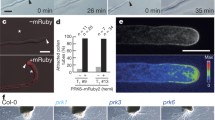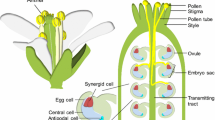Abstract
The concept of a pollen tube attractant was proposed in the late nineteenth century when pollen tubes were found to grow toward excised pistil tissues on medium. Since then, for about 140 years, plant biologists have tried to identify the pollen tube attractants. However, no molecule has been convincingly demonstrated to be the true attractant that actually controls the navigation of pollen tubes in the pistil. The past decade has seen substantial progress in this field in terms of our understanding of the various mechanisms of pollen tube guidance. It was suggested that diffusible pollen tube attractants might provide localized signals that affect the directional growth of the pollen tube, especially in the last phase of guidance by the target female gametophyte. Here, we review the mechanisms of pollen tube guidance, with special focus on the gametophytic guidance and the attractant. The necessary and appropriate conditions required by the true attractant will be discussed.



Similar content being viewed by others
References
Albach DC, Meudt HM, Oxelman B (2005) Piecing together the “new” plantaginaceae. Am J Bot 92:297–315
Cheung AY, Wang H, Wu HM (1995) A floral transmitting tissue-specific glycoprotein attracts pollen tubes and stimulates their growth. Cell 82:383–393
Crawford BCW, Ditta G, Yanofsky MF (2007) The NTT gene is required for transmitting-tract development in carpels of Arabidopsis thaliana. Curr Biol 17:1101–1108
Dong J, Kim ST, Lord EM (2005) Plantacyanin plays a role in reproduction in Arabidopsis. Plant Physiol 138:778–789
Dumas C, Gaude T (2006) Fertilization in plants: is calcium a key player? Semin CellDev Biol 17:244–253
Escobar-Restrepo JM, Huck N, Kessler S, Gagliardini V, Gheyselinck J, Yang WC, Grossniklaus U (2007) The FERONIA receptor-like kinase mediates male-female Interactions during pollen tube reception. Science 317:656–660
Goodhill GJ (1997) Diffusion in axon guidance. Eur J Neurosci 9:1414–1421
Gray-Mitsumune M, Matton DP (2006) The EGG APPARATUS 1 gene from maize is a member of a large gene family found in both monocots and dicots. Planta 223:618–625
Hall AE, Fiebig A, Preuss D (2002) Beyond the Arabidopsis genome: opportunities for comparative genomics. Plant Physiol 129:1439–1447
Hepler PK, Lovy-Wheeler A, McKenna ST, Kunkel JG (2006) Ions and pollen tube growth. Plant Cell Monogr 3:47–69
Heslop-Harrison J (1987) Pollen germination and pollen-tube growth. Int Rev Cytol 107:1–78
Higashiyama T (2002) The synergid cell: attractor and acceptor of the pollen tube for double fertilization. J Plant Res 115:149–160
Higashiyama T, Inatsugi R (2006) Comparative analysis of biological models used in the study of pollen tube growth. Plant Cell Monogr 3:265–286
Higashiyama T, Kuroiwa H, Kawano S, Kuroiwa T (1998) Guidance in vitro of the pollen tube to the naked embryo sac of Torenia fournieri. Plant Cell 10:2019–2031
Higashiyama T, Yabe S, Sasaki N, Nishimura Y, Miyagishima S, Kuroiwa H, Kuroiwa T (2001) Pollen tube attraction by the synergid cell. Science 293:1480–1483
Higashiyama T, Kuroiwa H, Kuroiwa T (2003) Pollen-tube guidance: beacons from the female gametophyte. Curr Opin Plant Biol 6:36–41
Higashiyama T, Inatsugi R, Sakamoto S, Sasaki N, Mori T, Kuroiwa H, Nakada T, Nozaki H, Kuroiwa T, Nakano A (2006) Species preferentiality of the pollen tube attractant derived from the synergid cell of Torenia fournieri. Plant Physiol 142:481–491
Huang BQ, Russell SD (1992) Female germ unit: organization, isolation, and function. Int Rev Cytol 140:233–293
Huck N, Moore JM, Federer M, Grossniklaus U (2003) The Arabidopsis mutant feronia disrupts the female gametophytic control of pollen tube reception. Development 130:2149–2159
Hülskamp M, Shneitz K, Pruitt RE (1995) Genetic evidence for a long-range activity that directs pollen tube guidance in Arabidopsis. Plant Cell 7:57–64
Ingouff M, Hamamura Y, Gourgues M, Higashiyama T, Berger F (2007) Distinct dynamics of HISTONE3 variants between the two fertilization products in plants. Curr Biol 17:1032–1037
Iwanami Y (1959) Physiological studies of pollen. J Yokohama City Univ 116:1–137
Johnson MA, Lord E (2006) Extracellular guidance cues and intracellular signaling pathways that direct pollen tube growth. Plant Cell Monogr 3:223–242
Johnson MA, Besser KV, Zhou Q, Smith E, Aux G, Patton D, Levin JZ, Preuss D (2004) Arabidopsis hapless mutations define essential gametophytic functions. Genetics 168:971–982
Kasahara RD, Portereiko MF, Sandaklie-Nikolova L, Rabiger DS, Drews GN (2005) MYB98 Is required for pollen tube guidance and synergid cell differentiation in Arabidopsis. Plant Cell 17:2981–2992
Kennedy TE, Serafini T, de la Torre JR, Tessier-Lavigne M (1994) Netrins are diffusible chemotropic factors for commissural axons in the embryonic spinal cord. Cell 78:425–435
Kikuchi S, Kino H, Tanaka H, Tsujimoto H (2007) Pollen tube growth in cross combinations between Torenia fournieri and fourteen related species. Breed Sci 57:117–122
Kim S, Mollet J-C, Dong J, Zhang K, Park S-Y, Lord EM (2003) Chemocyanin, a small basic protein from the lily stigma, induces pollen tube chemotropism. PNAS 100:16125–16130
Lord EM, Russell SD (2002) The mechanisms of pollination and fertilization in plants. Annu Rev Cell Dev Biol 18:81–105
Lush WM (1999) Whither chemotropism and pollen tube guidance. Trends Plant Sci 4:413–418
Lush WM, Grieser F, Wolters-Arts M (1998) Directional guidance of Nicotiana alata pollen tubes in vitro and on the stigma. Plant Physiol 118:733–741
Maheshwari P (1950) An introduction to the embryology of angiosperms. McGraw-Hill, NY
Márton ML, Cordts S, Broadhvest J, Dresselhaus T (2005) Micropylar pollen tube guidance by EGG APPARATUS 1 of maize. Science 307:573–576
Márton ML, Dresselhaus T (2008) A comparison of early molecular fertilization mechanisms in animals and flowering plants. Sex Plant Reprod 21
Mascarenhas JP, Machlis L (1962a) The hormonal control of the directional growth of pollen tubes. Vitam Horm 20:347–372
Mascarenhas JP, Machlis L (1962b) Chemotropic response of Antirrhinum majus pollen to calcium. Nature 196:292–293
Mascarenhas JP, Machlis L (1964) Chemotropic response of pollen of Antirrhinum majus to calcium. Plant Physiol 39:70–77
Mori T, Kuroiwa H, Higashiyama T, Kuroiwa T (2006) GENERATIVE CELL SPECIFIC 1 is essential for angiosperm fertilization. Nat Cell Biol 8:64–71
Nowack MK, Grini PE, Jakoby MJ, Lafos M, Koncz C, Schnittger A (2006) A positive signal from the fertilization of the egg cell sets off endosperm proliferation in angiosperm embryogenesis. Nat Genet 38:63–67
Pagnussat GC, Yu H-j, Ngo QA, Rajani S, Mayalagu S, Johnson CS, Capron A, Xie L-F, Ye D, Sundaresan V (2004) Genetic and molecular identification of genes required for female gametophyte development and function in Arabidopsis. Development 132:603–614
Palanivelu R, Preuss D (2006) Distinct short-range ovule signals attract or repel Arabidopsis thaliana pollen tubes in vitro. BMC Plant Biol 6:7
Palanivelu R, Brass L, Edlund AF, Preuss D (2003) Pollen tube growth and guidance is regulated by POP2, an Arabidopsis gene that controls GABA levels. Cell 114:47–59
Prado AM, Porterfield DM, Feijó JA (2004) Nitric oxide is involved in growth regulation and re-orientation of pollen tubes. Development 131:2707–2714
Punwani JA, Drews GN (2008) Development and function of the synergid cell. Sex Plant Reprod 21
Ray S, Park SS, Ray A (1997) Pollen tube guidance by the female gametophyte. Development 124:2489–2498
Reger BJ, Chaubal R, Pressey R (1992) Chemotropic responses by pearl millet pollen tubes. Sex Plant Reprod 5:47–56
Rotman N, Rozier F, Boavida L, Dumas C, Berger F, Faure JE (2003) Female control of male gamete delivery during fertilization in Arabidopsis thaliana. Curr Biol 13:432–436
Rotman N, Durbarry A, Wardle A, Yang WC, Chaboud A, Faure JE, Berger F, Twell D (2005) A novel class of MYB factors controls sperm-cell formation in plants. Curr Biol 15:244–248
Sekimoto H (2005) Plant sex pheromones. Vitamins Hormones 72:457–478
Shimizu KK, Okada K (2000) Attractive and repulsive interactions between and male gametophytes in Arabidopsis pollen tube guidance. Development 127:4511–4518
Sogo A, Tobe H (2005) Intermittent pollen-tube growth in pistils of alders (Alnus). PNAS 102:8770–8775
Steffen JG, Kang I-H, Macfarlane J, Drews GN (2007) Identification of genes expressed in the Arabidopsis female gametophyte. Plant J 51:281–292
von Besser K, Frank AC, Johnson MA, Preuss D (2006) Arabidopsis HAP2 (GCS1) is a sperm-specific gene required for pollen tube guidance and fertilization. Development 133:4761–4769
Wolfe AD, dePamphilis CW (1998) The effect of relaxed functional constraints on the photosynthetic gene rbcL in photosynthetic and non-photosynthetic parasitic plants. Mol Biol Evol 15:1243–1258
Wolters-Arts M, Lush WM, Mariani C (1998) Lipids are required for directional pollen-tube growth. Nature 392:818–821
Wu HM, Wang H, Cheung AY (1995) A pollen tube growth stimulatory glycoprotein is deglycosylated by pollen tubes and displays a glycosylation gradient in the flower. Cell 82:395–403
Yang H, Kaur N, Kiriakopolos S, McCormick S (2006) EST generation and analyses towards identifying female gametophyte-specific genes in Zea mays L. Planta 224:1004–1014
Acknowledgments
Our work on pollen tube guidance is supported by the Ministry of Education, Culture, Sports, Science and Technology, Japan (grant-in-aid for scientific research on priority areas no. 18075004, grant-in-aid for Scientific Research (B) no. 19370017, and PRESTO to T.H.).
Author information
Authors and Affiliations
Corresponding author
Additional information
Communicated by Thomas Dresselhaus.
Electronic supplementary material
Below is the link to the electronic supplementary material
Movie S1. See text and the legend of Fig.2 for details. This movie is 64 times faster than the normal speed. (MOV 25.1 mb)
Movie S2. See text and the legend of Fig.3 for details. This movie is 64 times faster than the normal speed. (MOV 17.8 mb)
Rights and permissions
About this article
Cite this article
Higashiyama, T., Hamamura, Y. Gametophytic pollen tube guidance. Sex Plant Reprod 21, 17–26 (2008). https://doi.org/10.1007/s00497-007-0064-6
Received:
Revised:
Accepted:
Published:
Issue Date:
DOI: https://doi.org/10.1007/s00497-007-0064-6




